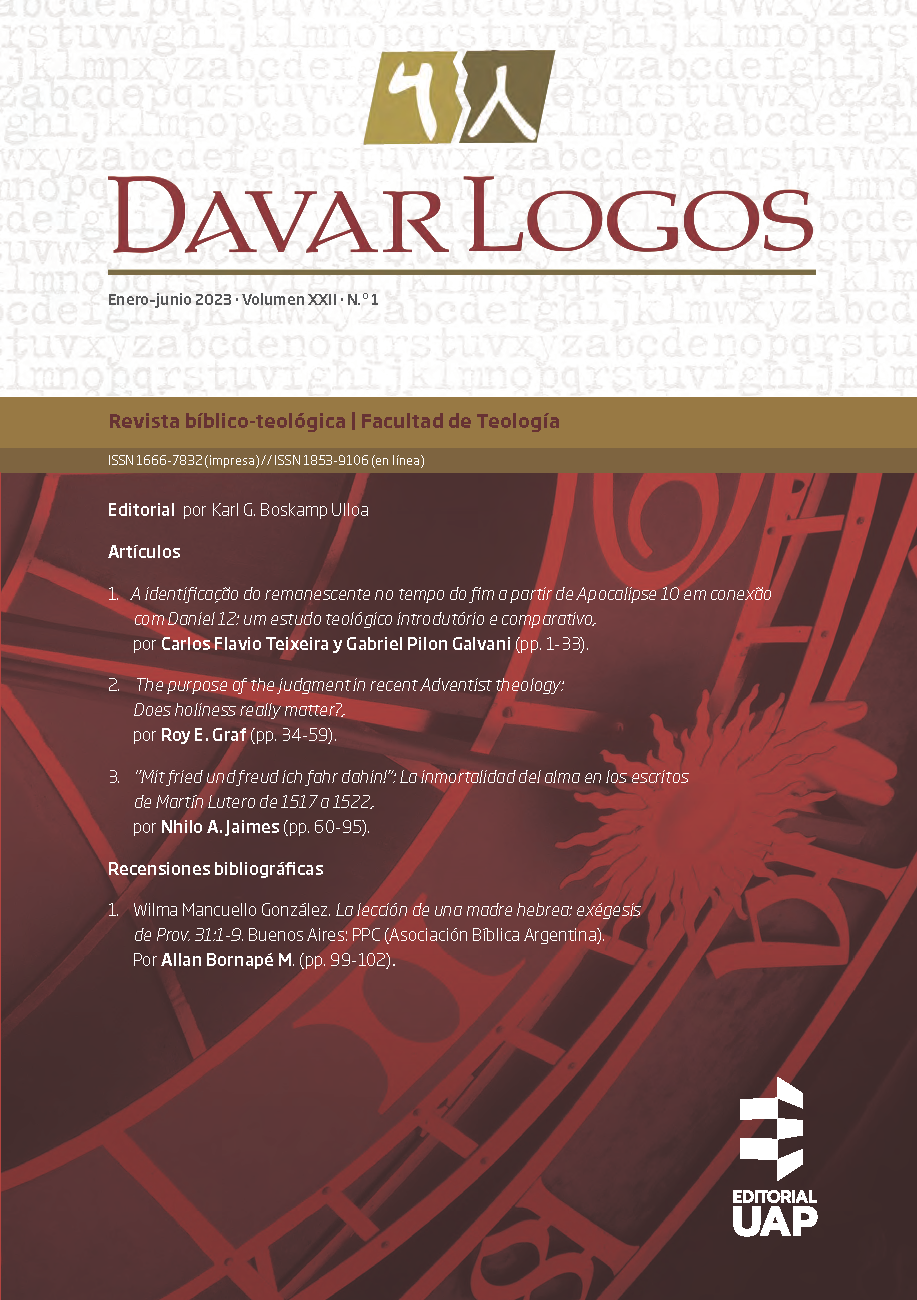The identification of the end-time remnant from Revelation 10 in connection with Daniel 12: An introductory and comparative theological study
DOI:
https://doi.org/10.56487/dl.v22i1.1076Keywords:
Daniel 12 − Revelation 10 − Main theological elements − Prophetic connections − RemnantAbstract
The present article, of a theological, introductory and comparative nature, consists of a panoramic recapitulation of the theological elements that appear in Revelation 10 and its connection with Daniel 12, signaling its importance for identifying the identity and mission of the remnant in the time of the end. Apparently, this intertextual combination has been little explored in the most recent proposals for theological research on the subject. In this context, it seems interesting to remember what are the elementary points that make up both chapters, in order to observe that they are connected, how this is done, and what are the implications of this in the conception of a biblical-systematic theology of the remnant. This proposal also seeks to highlight who is this remnant that can be identified from such a connection, exercising a relevant hermeneutical role since the beginnings of the SDA. To do so, the grammatical-historical-canonical method of biblical interpretation will be used—observing the sola, tota and prima Scriptura principles—and using bibliographical research as a research method. As a guide, this study will initially highlight the main theological concepts identifiable in Revelation chapter 10—the characteristics of the revelatory agent, the form/formula of revelation, the recipients of revelation, the specific content revealed (sealed/unsealed), the time components relating to the revelation, the peculiar purpose of the revelation, and the effects of the revelation. Then, the occurrence and connection of some of these same elements, albeit embryonic, in Daniel 12 will be verified. Finally, after being contextually observed, the theological components are compared, evidencing the relevance of their joint understanding and the resulting theological identification of the SDA as fulfillment of the prophetic identity and mission of the end-time remnant.Downloads
References
Todos os usos linguísticos do grego foram baseados na obra O Novo Testamento grego: Com introdução em português e dicionário grego-português, 4.ª ed. revisada (São Paulo, BR: Sociedade Bíblica do Brasil, 2008), exceto quando indicado o contrário.
Exemplos de uso no AT (Nm 21,29; 1 Re 4,7; 4,8; 13,30; Pv 23,29; Os 7,13; 9,12; Is 1,4.11.24; 3,9; 5,8.11.18.20.21.22; 10,1.5; 17,12; 18,1; 24,16; 28,1; 29,1.15; 30,1; 31,1; 33,1; Jr 4,13; 6,4; 10,19; 13,27; 27,27; 31,1; Lm 5,16; Ez 13,3.18; Am 5,18; 6,1; Hc 2,6.12.19; Sf 2,5).
Exemplos de uso no NT (Mt 11,21; 18,7; 23,13.14.15.16.23.25.27.29; 24,19; 26,24; Mc 13,17; 14,21; Lc 6,24.25.26; 10,13; 11,42.43.44.46.47.52; 17,1; 21,23; 22,22; 1 Co 9,16; Jd 11; Ap 8,13; 9,12; 11,14; 12,12; 18,10.16.19).
As aparições de Cristo nas visões aos profetas do Antigo Testamento também aparecem relacionadas à nuvens (Sl 104,3; Dn 7,13).
A conexão intra-bíblica entre os conteúdos de Daniel e Apocalipse, bem como a importância de um para compreensão do outro, pode ser notada nas alusões que o segundo faz do primeiro, estabelecendo assim sua dependência daquele. Como bem lembra Richard Lehmann: “embora certos livros da Bíblia sejam usados mais do que outros em Apocalipse, há uma ausência total de citações formais. Mais da metade das referências são extraídas dos Salmos, das profecias de Isaías, Ezequiel e do livro de Daniel. Entretanto, […] proporcionalmente à sua extensão, o livro de Daniel é de longe o mais usado” (“Relações entre Daniel e Apocalipse,” em Estudos sobre Apocalipse: temas introdutórios, ed. Frank B. Holbrook [Engenheiro Coelho, BR: Unaspress, 2017], 163).
A dimensão horizontal e vertical da revelação feita pelo anjo forte a João encontra seu correspondente na mesma combinação presente no livro de Daniel. Essa é mais uma evidência da perspectiva profética historicista de continuidade que une os dois livros. Para um estudo sobre o tema, ver Arthur J. Ferch, “Autoria, teologia e propósito de Daniel: teologia e propósito,” em Estudos sobre Daniel: origem, unidade e relevância profética, ed. Frank B. Holbrook (Engenheiro Coelho, BR: Unaspress, 2009), 45-48.
Todos os usos linguísticos do hebraico foram baseados em James Swanson, Dictionary of biblical languages with semantic domains: Hebrew (Old Testament) (Oak Harbor, WA: Logos Research Systems, Inc., 1997), exceto quando indicado o contrário.
Sobre a presença de duas testemunhas nesse contexto de revelação, como cumprimento do simbolismo previsto em Dt 19,15, ver Zdravko Stefanovic, Daniel: Wisdom to the wise; Commentary on the book of Daniel (Nampa, ID: Pacific Press Publishing Association, 2007), 442.
Acerca das similaridades e diferenças entre este livrinho e o rolo mencionado em 5,2, ver Kenneth Mathews Jr., Revelation reveals Jesus: An explanation of the Greek text and application of the symbolism therein (Greenville, SC: Second Coming Publishing, 2012), 502.
Francis D. Nichol e Vanderlei Dorneles, eds., Comentário bíblico adventista do sétimo sia, vol. 7 (Tatuí, BR: Casa Publicadora Brasileira, 2014), 883.
C. Marvyn Maxwell, God cares: The message of revelation for you and your family (Nampa, ID: Pacific Press Publishing Association, 1985), 279.
Ellen G. White, “Manuscrito 32”, 1896, parágrafo 38, acessado em 13 fev. 2023, https://legacy.egwwritings.org/?ref=en_Ms32-1896¶=5337.6.
Ellen G. White, Cristo triunfante (Tatuí, BR: Casa Publicadora Brasileira, 2002), 380.4.
Ibid., 376.1.
Ibid., 380.2.
Ibid.
Ibid., 380.6.
Ellen G. White, “Manuscrito 32”, 1896, parágrafo 3, acessado em 13 fev. 2023, https://legacy.egwwritings.org/?ref=en_Ms32-1896¶=5337.6.
White, Cristo triunfante, 380.3.
Ellen G. White, O Desejado de todas as nações, 22ª ed. (Tatuí, BR: Casa Publicadora Brasileira, 2004), 187.
White, Cristo triunfante, 380.4.
Ibid., 380.3.
Ibid., 375.3.
Ibid., 380.5.
Ibid., 380.6.
Ibid., 375.3.
Ibid., 380.3.
Ibid., 376.3.
Ellen G. White, “Manuscrito 4”, 1888, parágrafo 21, acessado em 13 fev. 2023, https://legacy.egwwritings.org/?ref=en_Ms4-1888¶=3978.24.
Downloads
Published
Issue
Section
License
Copyright (c) 2023 DavarLogos

This work is licensed under a Creative Commons Attribution-NonCommercial-ShareAlike 4.0 International License.




